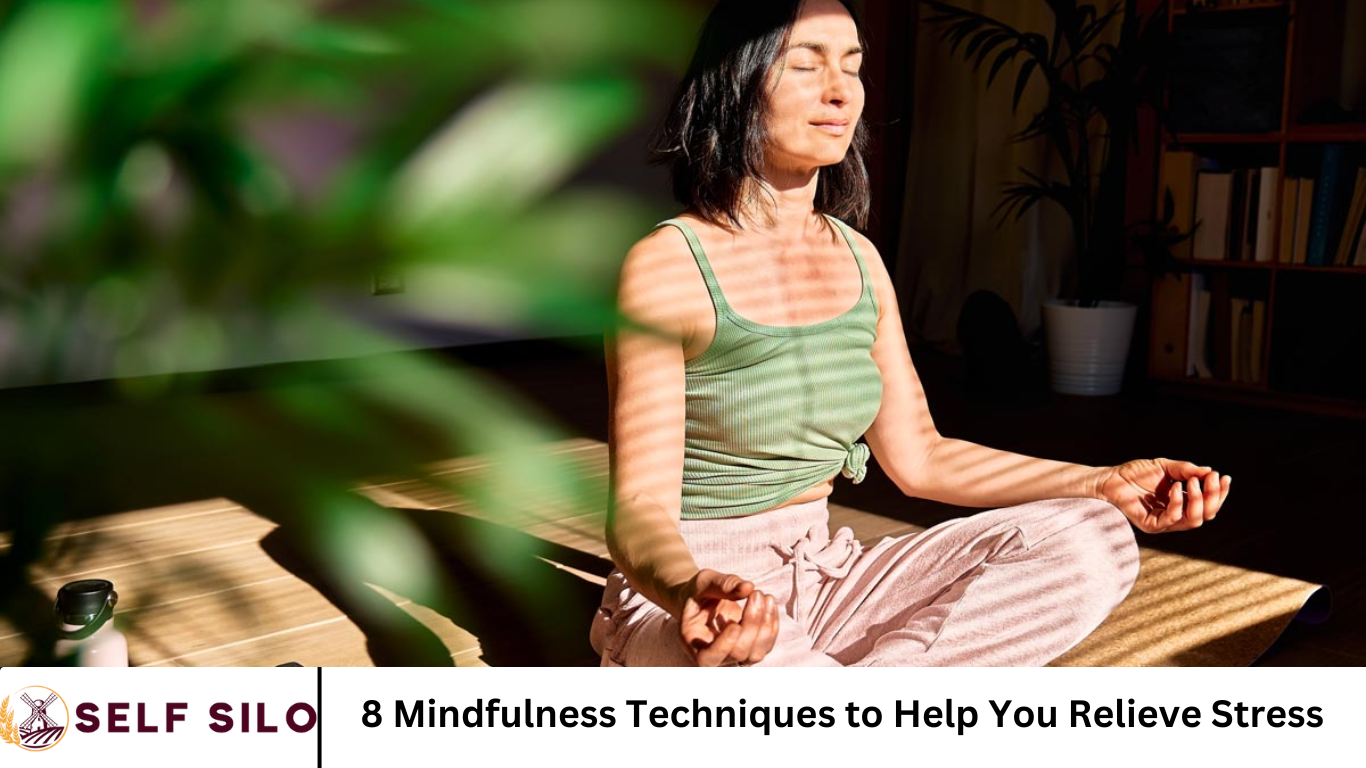Stress is a common part of modern life. Yet mindfulness—paying attention to the present moment without judgment—is a powerful, evidence‑based tool for reducing stress and improving mental well‑being. In this article, we’ll explore eight mindfulness techniques you can use today to relieve stress, enhance focus, and cultivate calm.
More Read: 6 Powerful Habits to Build Unstoppable Confidence
What Is Mindfulness & How Does It Reduce Stress? {#what-is-mindfulness}
Mindfulness means paying attention to the present moment — to your breath, body, thoughts, and environment — without judgment. Rooted in ancient Buddhist traditions and embraced by modern psychology, mindfulness encourages awareness and acceptance.
When practiced regularly, mindfulness:
- Reduces cortisol levels, the hormone associated with stress
- Improves emotional regulation, helping you respond rather than react
- Enhances focus, memory, and decision-making
- Boosts overall mental health, including resilience to anxiety and depression
By training the mind to stay present, we break free from rumination about the past or worry about the future—root causes of stress.
Why Mindfulness Matters for Stress Relief {#why-mindfulness-matters}
Stress impacts every system in the body—from the cardiovascular system to digestion, sleep, and mental clarity. Long-term stress increases your risk of:
- High blood pressure
- Heart disease
- Depression and anxiety
- Cognitive decline
Mindfulness acts as a natural antidote, helping you press “pause” on stress. By focusing on the here and now, you send a signal to your nervous system that it’s safe—dampening the stress response and activating the parasympathetic nervous system (rest-and-digest mode).
How to Build a Daily Mindfulness Routine {#build-routine}
Consistency is integral. Follow these steps to integrate mindfulness into your daily life:
- Schedule 5–15 minutes daily — early morning or evening works well.
- Choose a quiet, comfortable spot—likely where you won’t be disturbed.
- Start small—3–5 minutes per session if you’re new.
- Use a timer or app (like Headspace, Calm, Insight Timer).
- Be kind to yourself—mind wandering is normal. Simply notice and return to your focus.
- Extend mindfulness into daily activities—eating, walking, dishwashing, talking.
1️⃣ Mindful Breathing: Anchor in the Present {#technique-1}
What it is
A foundational meditation practice—focus on your breath, noticing inhale and exhale sensations.
How to practice:
- Sit or lie comfortably.
- Close your eyes and breathe naturally.
- Focus on the rise/fall of your abdomen or air entering your nostrils.
- When your mind wanders, gently guide it back.
- Practice for 5–10 minutes daily.
Benefits:
- Lowers heart rate and blood pressure
- Stops racing thoughts immediately
- Helps you regain control during moments of acute stress
2️⃣ Body Scan Meditation: Release Physical Tension {#technique-2}
What it is
A guided practice that directs attention through different body parts, releasing tension and increasing awareness.
How to practice:
- Lie flat or sit with feet on the floor.
- Start at your toes, noticing any sensation.
- Gradually move up—feet, calves, thighs, pelvis, abdomen, chest, arms, neck, head.
- Pause in areas of tightness and breathe into them.
- Aim for 15–20 minutes, or 5–10 for deeper focus.
Benefits:
- Promotes full-body relaxation
- Helps identify chronic tension areas
- Improves sleep quality and somatic awareness
3️⃣ Mindful Movement: Walk, Stretch, or Practice Yoga {#technique-3}
What it is
Bringing awareness to bodily motion through gentle, deliberate movement.
How to practice:
- Mindful walking: Walk slowly, feel heel-to-toe, notice lift, move, foot-set contact.
- Gentle stretching: Breathe deeply with each stretch, feeling the expansion.
- Yoga: Choose a few slow-flow yoga poses with focus on breath and alignment.
Benefits:
- Eases stiffness and improves circulation
- Combines physical activity’s benefits with mindfulness
- Grounding, ideal if stillness isn’t your style
4️⃣ Five Senses Exercise: Ground Yourself {#technique-4}
What it is
A quick technique to calm racing thoughts and anchor you in the present using sensory awareness.
How to practice:
- Pause and center by taking a few breaths.
- Slowly notice:
- 5 things you see
- 4 things you feel (texture/temperature)
- 3 things you hear
- 2 things you smell
- 1 thing you taste
Benefits:
- Fast grounding technique for anxiety attacks
- No need for sitting or setup—useable anytime
- Enhances sensory appreciation and mental clarity
5️⃣ Mindful Eating: Savor Every Bite {#technique-5}
What it is
Eating slowly and attentively—notice taste, texture, aroma, and bodily sensations.
How to practice:
- Eat one meal/drink a day mindfully.
- Before eating, pause and breathe 3 times.
- Observe appearance, aroma, texture.
- Chew slowly—count up to 20 per bite.
- Reflect on farmers, harvesters, your body digesting.
Benefits:
- Improves digestion and portion control
- Strengthens connection between mind and body
- Helps break unhealthy eating patterns
6️⃣ Loving‑Kindness Meditation: Cultivate Compassion {#technique-6}
What it is
Also called “metta meditation,” it focuses on sending kindness to self and others.
How to practice:
- Sit comfortably, close eyes.
- Mentally repeat phrases like:
- “May I be safe.”
- “May I be happy.”
- “May I be healthy.”
- “May I live with ease.”
- Extend these to loved ones, neutral people, difficult people, and all beings.
- Practice 10–20 minutes.
Benefits:
- Reduces self-criticism and boosts self-esteem
- Enhances empathy and positive social connection
- Helps manage anger and interpersonal stress
7️⃣ Gratitude Journaling: Shift Perspective {#technique-7}
What it is
A daily written practice to intentionally notice and appreciate life’s positives.
How to practice:
- Keep a gratitude journal or use an app.
- Write 3–5 things you’re thankful for—events, people, simple pleasures.
- Reflect on why you’re grateful.
- Practice daily, preferably morning or evening.
Benefits:
- Shifts focus to positives, reducing stress
- Improves mood and sleep quality
- Boosts resilience—less impacted by daily stressors
8️⃣ Thought Labeling: Watch Thoughts Without Clinging {#technique-8}
What it is
A mindfulness technique to objectively observe thoughts and let them pass.
How to practice:
- Sit quietly and notice thoughts as they arise.
- Mentally label them: “thinking,” “worrying,” “planning,” “judging.”
- Don’t judge or engage—just label and let go.
- Return to your breath or body sensation.
Benefits:
- Reduces reactivity to stress-inducing thoughts
- Enhances mental clarity and emotional regulation
- Helps detach from unhelpful thought patterns
Frequently Asked Question
What are the best mindfulness techniques for reducing stress quickly?
Some of the fastest-acting mindfulness techniques for stress relief include mindful breathing, the 5-senses grounding exercise, and body scan meditation. These methods can help calm the nervous system within minutes and restore a sense of balance.
How long should I practice mindfulness each day to relieve stress?
Start with 5 to 10 minutes per day, gradually increasing to 20–30 minutes. Even short, consistent sessions have been shown to significantly reduce stress over time.
Can mindfulness really help with chronic stress or anxiety?
Yes. Scientific studies have shown that regular mindfulness practice can lower cortisol levels, reduce symptoms of anxiety, and improve emotional regulation, making it effective for managing chronic stress and anxiety.
Do I need to meditate to practice mindfulness?
No. While meditation is a powerful form of mindfulness, you can also practice it during daily activities like eating, walking, or brushing your teeth. The key is bringing full, non-judgmental attention to the present moment.
Which mindfulness technique is best for beginners?
Mindful breathing is often the easiest and most accessible starting point. It doesn’t require any tools, can be done anywhere, and offers immediate calming effects.
How long does it take to see results from mindfulness?
Some people notice benefits immediately, such as a calmer mind or deeper breath. However, most people experience more lasting stress relief after 2 to 8 weeks of consistent daily practice.
Can mindfulness be used during a panic or anxiety attack?
Yes. Techniques like the 5-4-3-2-1 grounding method, mindful breathing, or simply labeling thoughts can help ground your awareness and bring down anxiety levels during high-stress moments.
Conclusion
Mindfulness isn’t just a practice—it’s a way of life. By regularly incorporating these eight simple techniques—from mindful breathing to gratitude journaling—you’ll build stress resilience, sharpen focus, and enhance your overall well-being. 🧘♀️ Getting started tip: Choose one technique, practice 5 minutes daily for two weeks, then gradually add others. Soon, mindfulness will become an effortless, fulfilling part of your day.


